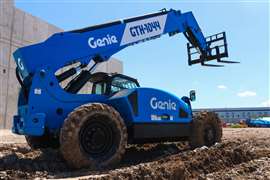Read this article in Français Deutsch Italiano Português Español
How the world’s cities are going digital and what it means for construction
04 November 2025
US-based construction and infrastructure technology firm Bentley Systems held its annual Year in Infrastructure and Going Digital Awards user conference in Amsterdam, the Netherlands, in October.
 The Cities industry breakout session at the 2025 Bentley Systems Year In Infrastructure event. Image: KHL
The Cities industry breakout session at the 2025 Bentley Systems Year In Infrastructure event. Image: KHL
Construction Briefing was in attendance, noting the key issues facing contractors navigating the digital world while building in urban environments.
Here are some findings from the event’s Cities industry breakout session – and what they might mean for contractors globally.
Municipalities are increasingly relying on digital management tools
The Cities breakout session opened with a video feature from Portland, Oregon, US, setting the stage for a discussion on how global cities are leveraging digital tools to manage a myriad of goals – chief among them urban construction that is efficient, cost-effective, and sustainable.
“The City of Portland, like every agency, has a limited number of resources,” said one individual in the brief video. “We strive to design things in a way that is efficient, buildable and constructable. There’s a direct relationship between how efficient we are, how much time we spend on the project, and how much we actually build.”
It was the perfect setup for the session’s panellists: Rebecca Herrera Rodríguez, Head of Building Permit Innovation, City of Madrid; James Moore, Global Technical Director, Hatch; and Andrius Jurelionis, Dean of the Civil Engineering and Architecture Faculty, Kaunas University of Technology.
Discussing how urban areas can leverage today’s digital tools, Rodríguez outlined her city’s major digital transformation initiative: Madrid Capital Digital.
“It focuses on improving public digital services across all the city departments, but also the city districts,” she explained. “For construction and urban infrastructure changes, we are aiming for a more resilient, sustainable city with projects like converting a highway that separates two different districts into a green corridor… using BIM methodology from the beginning of the project and now in the construction phase.”
She also discussed Madrid’s new Digital Building Permit programme, which seeks to automate the construction permitting process. Users can upload BIM models in IFC format to help expedite project approval.
In addition to time savings, Rodríguez noted, “It changed the way everyone can work on [the project], because for the first time architects and developers are able to check from the beginning of their project if it’s compliant or not, instead of waiting until the last part of the design.”
For Madrid, construction firms that cannot meet the municipality’s digital expectations are unlikely to win contracts and may be discouraged from bidding.
Digital tools can impact a broad set of project goals
 Construction is increasingly embracing digital tools. Image: Adobe Stock
Construction is increasingly embracing digital tools. Image: Adobe Stock
James Moore noted that his firm, Hatch, works with both private and public sector clients – each with differing agendas when leveraging modern technology.
“Public sector customers have to worry about the public. It’s a very broad remit,” explained Moore. “Private customers are focused on a specific metric: return on investment, financials, etc.
“So, there’s a distinction between customer types.”
It’s an important distinction for construction contractors and subcontractors to understand, as building for a city carries vastly different priorities than for a private client.
Moore said public clients tend to have a deeper understanding of the purpose of digital tools. He described how, in the past, a project would pass through multiple departments on paper – from design to land use to planning to zoning.
“Somebody would take a set of drawings off a shelf, make a copy, and bring them all back together — but they were done by different people at different times,” said Moore, noting that once a project wrapped, that information would be boxed up and stored, often to be misplaced or lost over time.
“Our job [at Hatch] was to figure out how to integrate all that. It was very time-consuming,” he added. “Now, the value of a digital twin is that all that information can be brought together not just into a single resource, but one that has operational viability over time.”
For public-sector clients — where multiple departments interact with a single project — the benefit is a layered digital system that addresses each department’s needs while contributing to a shared, permanent digital record.
On the private side, Moore noted that implementing new technology can present a cost dilemma, as the value of a digital twin or other asset isn’t always immediately visible.
“Developers are very dollar-driven,” he said. “They’ll consider it, but it’s one of the first things that gets cut out; people want to recognise the value.”
For contractors, being able to quantify how digital tools reduce delays and uncertainty may be as persuasive as proving cost savings.
A better picture of the city above and below the surface
A growing advantage of digital tools in urban environments is better control of information related to subsurface and connected assets.
“They’re hidden. Out of sight, out of mind,” Moore noted. “We often forget there’s a lot of stuff below. The only time we think about it is when something goes wrong.”
But advanced sensing tools and active digital twins can promote less reactive and more proactive construction. Instead of waiting for a break, a subsurface digital twin can enable preventative work, reducing damage costs and limiting emergency repairs.
“[If] that water main is 125 years old, [and] it has a 75-year life, we should probably go in here and look at it,” Moore said.
 The Cities breakout session took place at Bentley Systems Year in Infrastructure event, which was held in Amsterdam. Image: Adobe Stock
The Cities breakout session took place at Bentley Systems Year in Infrastructure event, which was held in Amsterdam. Image: Adobe Stock
The broader impact of digital tools on utilities can also drive sustainability goals.
Providing a case study, Andrius Jurelionis described how Kaunas University of Technology in Lithuania has developed a digital platform to track the main operational parameters of its campus.
“Together with Bentley and other industry partners, we work on a platform where we track main operational parameters of our campus,” he said. “It’s basically meant for calculating real-time CO₂ footprint.”
The system tracks more than 200 parameters – including indoor environment, energy production and consumption, occupancy, and EV charging.
“The main idea is to develop a model that can serve a small city. It integrates two things that are important to us: sustainability and energy resilience,” he explained, noting that the project recently integrated live data from the national grid. “We know at every hour how the energy is produced in Lithuania, and the way we consume it.”
While subsurface and sustainability modelling may not yet be the norm for most construction clients, they could represent a new service offering: construction firms could provide digital twin modelling for infrastructure as an added service – creating recurring revenue streams and positioning themselves as long-term partners rather than short-term builders.
Time is the revelation
Across each discussion in the Cities breakout, time emerged as the hidden currency of digital transformation: time saved in permitting, coordination, and asset maintenance long after handover.
Whether through Madrid’s permitting reforms, Hatch’s data integration, or Kaunas University’s live energy modelling, the common goal was clear – to compress the time between design, decision, and delivery.
For construction, this signals a shift: digital technology is no longer only about precision or efficiency, but about reclaiming time – shortening schedules, extending asset life, and ensuring information endures beyond a single project cycle.
STAY CONNECTED


Receive the information you need when you need it through our world-leading magazines, newsletters and daily briefings.
CONNECT WITH THE TEAM










